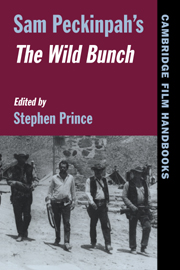Book contents
- Frontmatter
- Contents
- List of Contributors
- Introduction: Sam Peckinpah, Savage Poet of American Cinema
- 1 The Wild Bunch: The Screenplay
- 2 Peckinpah the Radical:The Politics of The Wild Bunch
- 3 “Back Off to What?” Enclosure, Violence, and Capitalism in Sam Peckinpah's The Wild Bunch
- 4 Ballistic Balletics: Styles of Violent Representation in The Wild Bunch and After
- 5 Re-Visioning the Western: Code, Myth, and Genre in Peckinpah's The Wild Bunch
- 6 The Wild Bunch: Innovation and Retreat
- Reviews and Commentary
- Filmography
- Select Bibliography
- Index
5 - Re-Visioning the Western: Code, Myth, and Genre in Peckinpah's The Wild Bunch
Published online by Cambridge University Press: 29 December 2009
- Frontmatter
- Contents
- List of Contributors
- Introduction: Sam Peckinpah, Savage Poet of American Cinema
- 1 The Wild Bunch: The Screenplay
- 2 Peckinpah the Radical:The Politics of The Wild Bunch
- 3 “Back Off to What?” Enclosure, Violence, and Capitalism in Sam Peckinpah's The Wild Bunch
- 4 Ballistic Balletics: Styles of Violent Representation in The Wild Bunch and After
- 5 Re-Visioning the Western: Code, Myth, and Genre in Peckinpah's The Wild Bunch
- 6 The Wild Bunch: Innovation and Retreat
- Reviews and Commentary
- Filmography
- Select Bibliography
- Index
Summary
The Wild Bunch was made just as the Western as a reliably profitable program staple was supposedly dying out after being the most dependably audience-satisfying structural format for more than seven decades. It is worth noting that despite evidence of the current “collapse” of the Western as a marketable commodity, there are still more Westerns in cinema history than any other Hollywood genre. Just as The Great Train Robbery (1903), Stage-coach (1939), and High Noon (1952) reconfigured the landscape of the American Western (and, in the case of The Great Train Robbery, helped to create it), Sam Peckinpah's The Wild Bunch re-created the genre of the Western for the late 1960s. This film remains fresh and vital today because of the enormity of its revisionist enterprise. In its use of slow-motion photography to accentuate key moments of suspense and/or violence, in its creation of an entirely new set of character values for its protagonists (notably William Holden as Pike Bishop and Ernest Borgnine as Dutch Engstrom), and in its elegiac embrace of the “end of the old West,” The Wild Bunch, particularly in the extended director's cut (which I saw in a preview screening in 1969 as a writer for Life magazine and which is now readily available on home video), it constitutes a complete re-visioning and reconfiguration of classical Western genre values in a way that sweepingly calls all previous examples of the genre into question.
It is also interesting that The Wild Bunch should appear at the same time as George Roy Hill's Butch Cassidy and the Sundance Kid (1969), a film that offered a far more conventional and sentimental view of the West than The Wild Bunch, although it, too, culminated in a fatal shoot-out for the protagonists.
- Type
- Chapter
- Information
- Sam Peckinpah's The Wild Bunch , pp. 155 - 174Publisher: Cambridge University PressPrint publication year: 1998

